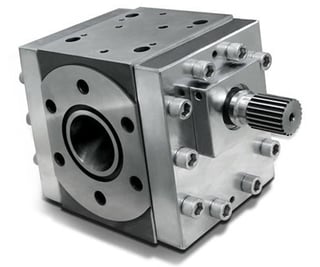 Extrusion Melt Pumps, otherwise known as gear pumps, can be useful additions to just about any extrusion line. This technology has been around for a considerable number of years. Many extrusion processors have been taking advantage of the benefits since then, translating into positive impacts for these processors bottom line!
Extrusion Melt Pumps, otherwise known as gear pumps, can be useful additions to just about any extrusion line. This technology has been around for a considerable number of years. Many extrusion processors have been taking advantage of the benefits since then, translating into positive impacts for these processors bottom line!
As with all things, technology has continued to advance, even with melt pumps. With advances in motors, controls and materials, today’s melts pumps run more efficiently, consuming less energy than earlier counterparts. Many manufacturers have taken further steps to minimize any previous disadvantages or stigma. However, the same basic operational principles still apply.
Melt pumps are positioned in-line, downstream of the extruder screw and barrel, screens and breaker plate. Consisting of a temperature controlled, inlet port, housing and outlet port. At the heart of it, the housing contains a set of intermeshing, precision gears (typically spur or helical bevel designs) rotating with self-lubricating bearings from the melt. This rotation works to draw in the melt from the extruder, acting as a displacement pump as molten material then exits into the die. The gears or pump is driven by the combination of an electric gear motor with the resultant speed or RPM’s, controlled with a variable speed drive.
The output RPM can be a set point to match a desired throughput rate or it can be synchronized to match the downstream puller speed. For total closed loop control, it can also be tied in with an upstream gravimetric feed hopper system. These latter options will provide varying degrees up to maximum control, to achieve production of close tolerance end products. Most importantly though, having consistent throughput rates will limit any unnecessary residence time.
Another advantage of using a melt pump is increased output stability. This can be improved to 0.1% versus the conventional extruder screw which, on its own, can have variations of as much as 10%. It can also compensate for an extruder with poor output capacity, due to wear or use of an improper screw and barrel designs. It will minimize or negate the effects of non-homogenous materials, such as running high percentages of regrind or off-spec grades of virgin material, as an example.
One of its most measurable and widely known benefits is the ability to produce a close tolerance extrudate at the die. Taking away any previous causes of dimensional instability up to this point. Using a melt pump will improve product quality, that may not have been previously possible without it.
Melt pumps are of course another piece of equipment for the processor to consider and maintain. This includes the upfront capital purchase cost. Relative simplicity aside, they are not always relatively cheap. Once installed they will have some periodic cleaning requirements for continued best performance. They will require routine inspection and preventative maintenance activities with the presence of additional moving parts.
To continue to work properly, it is critical the precision gears, remain just that, precise! Corrosive, abrasive or fiber filled materials will wear and shorten the useful life span of these gears. Generally, these types of plastic materials are not recommended to be run through a conventional melt pump. Surface treatments and different gear materials are available, at a cost, to prolong life span if absolutely required.
Processors of heat sensitive resins should note, although the materials interaction with the intermeshing gears is generally a low shear experience, some degradation can occur inside the pump components if there is any extended residence time. Synchronization mentioned previously will prevent this. For added consideration a melt pump can generally allow for running a lower temperature profile on the extruder – an added benefit for heat sensitive materials–further lessening chances for degradation.
Past melt pumps were known to have dead spots. Most that are available today will have precise fitting flanges matched to your brand of extruder. If not already available, it is a good idea to get some custom machined to fit. Minimizing or eliminating areas where any type of material can hang up and degrade is extremely important! Producing quality products, not inadvertently compromised by carbon contaminants, will allow you to get the most out of this equipment. Don’t sacrifice one for the other.
Overall, there are many benefits from using melt pumps. They can be used in combination with most any extruder, single or twin screw. They are generally easy to install and can often be integrated with your existing line controls.
If you have a requirement for consistent close tolerance extrusion, a need to run high quality, low cost products using off spec material or regrind, or for any related application or need it is time you consider adding a melt pump to your valued extrusion lines. When up and running, the payback time is typically short and the investment generates profitability for years to come.
Learn more about improving your profitability with proper purging compounds and processes.








Comments